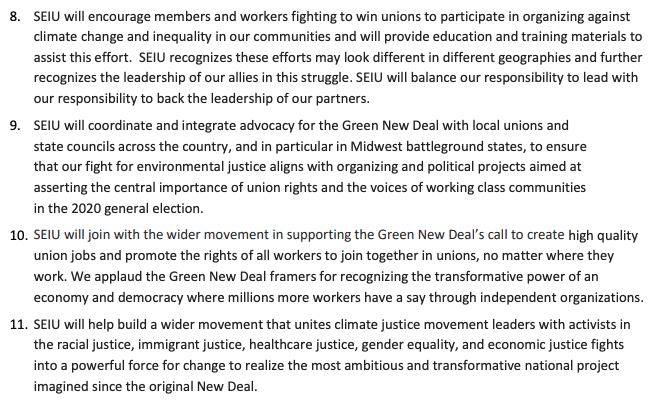From pv magazine USA.
American unions are divided on the Green New Deal proposal for decarbonization through renewable energy and other means coupled with massive economic mobilization and social programs.
However, those local and state unions which have defied national leaders to support the proposed policy package have been lifted by an endorsement of the idea by national organization the Service Employees International Union (SEIU). At its convention in Minneapolis, the 1.9 million-strong body passed a resolution not only supporting the Green New Deal in principle, but stating it will “coordinate and integrate advocacy for the Green New Deal with local unions and state councils across the country”.
Sections 8-10 of the document are particularly notable:

Opposition by energy workers’ unions
While the SEIU has a broad membership in hospitals, nursing homes, janitorial and food service workers, unions with workers in the energy industry have been either cooler or actively hostile to the Green New Deal at national level.
On March 8, the energy committee of the AFL-CIO [American Federation of Labor and Congress of Industrial Organizations] sent a sharply worded letter to Green New Deal sponsors senator Ed Markey (Democrat, Massachusetts) and representative Alexandria Ocasio-Cortez (Democrat, New York) describing the proposal as a “threat” to members’ jobs and standards of living:
The Green New Deal resolution is far too short on specific solutions that speak to the jobs of our members and the critical sectors of our economy. It is not rooted in an engineering-based approach and makes promises that are not achievable or realistic.
We will not accept proposals that could cause immediate harm to millions of our members and their families. We will not stand by and allow threats to our members’ jobs and families’ standard of living to go unanswered.
Perhaps not surprisingly, the letter was signed by the head of United Mine Workers of America. However, it also secured backing from the International Brotherhood of Electrical Workers (IBEW), the union whose members are likely to benefit most from a rapid transition to renewables, given the associated need for electricians such a changeover would entail.
The Laborer’s International Union of North America (LiUNA!) is also among Green New Deal critics, and president Terry O’Sullivan has been outspoken about his opposition. Signatories to the protest letter also include the powerful Building Trades Council.
The SEIU statement is not the first time the body has diverged from the views held by the AFL-CIO. In 2005, the SEIU helped form the Change to Win coalition as an alternative to the AFL-CIO only to see the new federation lose member unions including LiUNA!
Splits at a local level
While most national labor leaders have been cool on the Green New Deal, the proposal has had endorsements by state chapters and local unions.
IBEW local 103, which boasts more than 6,000 members and has a wind turbine at its union hall in Boston, endorsed the idea and IBEW in San Francisco put forward a resolution in favor of the proposal that was passed by the San Francisco Labor Council in April. The Maine AFL-CIO endorsed Democrat state representative Chloe Maxmin’s bill to create a Green New Deal program for the state, which passed the House this week.
However, it is notable such local units are much smaller than the 560,000 members of LiUNA! and represent only a tiny proportion of the 750,000 IBEW members nationwide – let alone the 12 million or so workers associated with the AFL-CIO.
Building renewables or shutting down fossil fuels
State union leaders have also come out against the Green New Deal. Notably, the president of California’s Building and Construction Trades Council – which represents 400,000 workers – is calling for a “blue collar revolution” at the state’s Democratic convention next week. That is in response to LA Mayor Eric Garcetti’s Green New Deal for Los Angeles proposal, which calls for shutting down three large natural gas fired power plants.
The differing views underline the dilemma that, while developing renewable energy remains broadly popular, including among union members, shuttering conventional power generation assets can be controversial due to related lay-offs.
With electricity demand relatively static, bringing more renewables online will inevitably cause coal, gas and nuclear power plants to close. The resulting arguments could be a major lesson for policymakers in how to develop less politically volatile strategies for decarbonization, particularly in areas where union support is vital for political success.
This content is protected by copyright and may not be reused. If you want to cooperate with us and would like to reuse some of our content, please contact: editors@pv-magazine.com.



The example of Spain’s successful coal shutdown suggests that political leaders in the energy transition have to stand firm. If they do, unions will go along with a generous retraining and restructuring package. The transition itself is not negotiable, only how it happens.
Where does the UAW stand? The three legacy carmakers all talk up their EV plans but these are “some day soon”. The company driving EV growth, Tesla, is regrettably anti-union. Its success does not help current UAW members. But the union leaders can read charts and must know where the future lies: including Democratic political pressure on Tesla to unionize its plants.